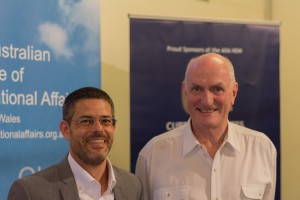Predicting Genocide
As one of his advisers during his first presidential campaign, Barack Obama attracted Professor Samantha Power from Harvard’s Kennedy School of Government. Power’s book A Problem from Hell: America and the Age of Genocide influenced Obama towards adopting a liberal interventionist policy in cases where genocide was occurring or likely to occur. Our speaker at Glover Cottages on 16 February was Associate Professor Ben Goldsmith from Sydney University, whose academic speciality is genocide forecasting. Such a growing early warning science should encourage liberal intervention, not just by the United States, but by every country with humanistic pretentions. It fits squarely within the moral compass of Responsibility to Protect – R2P. But whether this growing discipline has or does encourage outside intervention has not yet been satisfactorily answered.
Ben’s work involves creating a data set based on probabilities. From this, forecasts are made of likely genocidal situations. His models do not include what he termed ‘politicide’ – the intentional killing of a political group by a state, a political opposition or by courts. He said that accurate forecasting was still very much a hit and miss science, and genocide itself was still a comparatively rare event. Indeed, between 1956 and 2010 there had been a downward trend in occurrences. Of 15 annual predictions of genocides made by his group, only one had come to pass.
Ben’s list of countries at risk of genocide is in many ways the converse of Steve Killelea’s well-known Global Peace Index – an annual list of the most peaceful countries in the world, based on such criteria as adherence to the rule of law, respect for women’s rights, lack of corruption, and income equality. Scandinavian countries, followed by a few other European countries, Canada, Australia and New Zealand invariably come out on top. Third world countries tend to languish at the bottom. Ben Goldsmith’s list of countries most at risk of genocide on the other hand is led by the Central African Republic, followed closely by Congo, Chad, Somalia, Angola, Myanmar, Sri Lanka, Ecuador, Burundi, Afghanistan, Syria and Libya. Tribal and sectarian conflict, poverty, uneven distribution of income, a sense of injustice, corruption and perceived exploitation are key drivers. But so, interestingly, is the advent of elections, which tend to be a focus of social grievances.
Ben’s work is part of an expanding global academic industry. He has attracted media interest as well as outside funding for his research. He admits that his predictive skills continue to be a work in progress. It will be interesting to see whether they lead to more accurate forecasts of genocide. Also, whether the international community will pay attention and, through the United Nations or otherwise, develop a convincing ability to respond and protect. As the one person said to Ben during question time: ‘Even if you can predict genocide more accurately, so what? What comes next?’ One thing that could come next, if the profit motive could be overcome, would be an international crack down on the arms trade, particularly of automatic small arms, the weapons of choice of those about to kill large numbers of people.
The vote of thanks was proposed by one of our new interns, Alexander Galitsky, of Armenian background. Speaking with feeling, Alexander said that if such work as Ben’s had been pursued at universities decades ago, the world might have been more conscious of and taken steps to prevent the massacre of Armenians by the Ottoman Empire from 1915 until the Empire’s collapse at the end of the First World War.
Report prepared by Richard Broinowski
For Ben Goldsmith’s powerpoint presentation, click here: Genocide Forecasting_AIIA_160216
For Atrocity Forecasting Prediction references, click here: AFP media pubs
